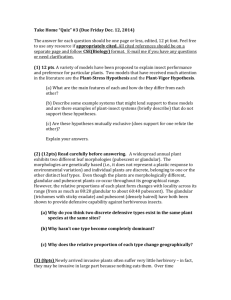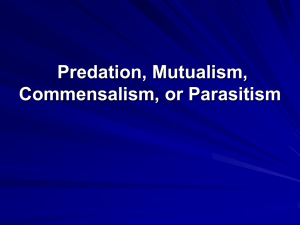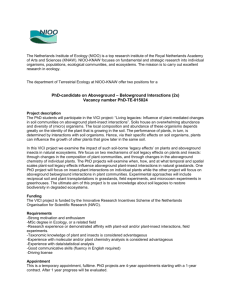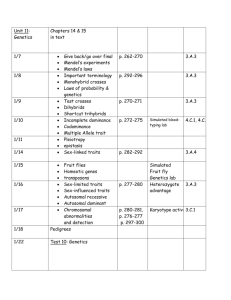apr book_outline for authors 250511
advertisement
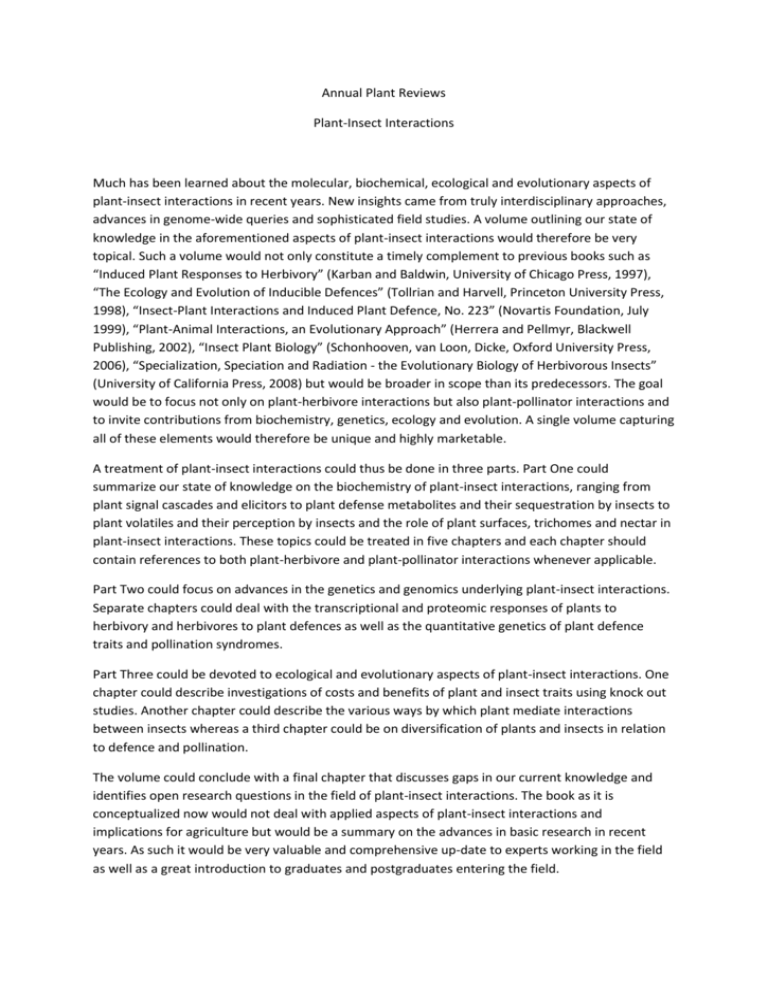
Annual Plant Reviews Plant-Insect Interactions Much has been learned about the molecular, biochemical, ecological and evolutionary aspects of plant-insect interactions in recent years. New insights came from truly interdisciplinary approaches, advances in genome-wide queries and sophisticated field studies. A volume outlining our state of knowledge in the aforementioned aspects of plant-insect interactions would therefore be very topical. Such a volume would not only constitute a timely complement to previous books such as “Induced Plant Responses to Herbivory” (Karban and Baldwin, University of Chicago Press, 1997), “The Ecology and Evolution of Inducible Defences” (Tollrian and Harvell, Princeton University Press, 1998), “Insect-Plant Interactions and Induced Plant Defence, No. 223” (Novartis Foundation, July 1999), “Plant-Animal Interactions, an Evolutionary Approach” (Herrera and Pellmyr, Blackwell Publishing, 2002), “Insect Plant Biology” (Schonhooven, van Loon, Dicke, Oxford University Press, 2006), “Specialization, Speciation and Radiation - the Evolutionary Biology of Herbivorous Insects” (University of California Press, 2008) but would be broader in scope than its predecessors. The goal would be to focus not only on plant-herbivore interactions but also plant-pollinator interactions and to invite contributions from biochemistry, genetics, ecology and evolution. A single volume capturing all of these elements would therefore be unique and highly marketable. A treatment of plant-insect interactions could thus be done in three parts. Part One could summarize our state of knowledge on the biochemistry of plant-insect interactions, ranging from plant signal cascades and elicitors to plant defense metabolites and their sequestration by insects to plant volatiles and their perception by insects and the role of plant surfaces, trichomes and nectar in plant-insect interactions. These topics could be treated in five chapters and each chapter should contain references to both plant-herbivore and plant-pollinator interactions whenever applicable. Part Two could focus on advances in the genetics and genomics underlying plant-insect interactions. Separate chapters could deal with the transcriptional and proteomic responses of plants to herbivory and herbivores to plant defences as well as the quantitative genetics of plant defence traits and pollination syndromes. Part Three could be devoted to ecological and evolutionary aspects of plant-insect interactions. One chapter could describe investigations of costs and benefits of plant and insect traits using knock out studies. Another chapter could describe the various ways by which plant mediate interactions between insects whereas a third chapter could be on diversification of plants and insects in relation to defence and pollination. The volume could conclude with a final chapter that discusses gaps in our current knowledge and identifies open research questions in the field of plant-insect interactions. The book as it is conceptualized now would not deal with applied aspects of plant-insect interactions and implications for agriculture but would be a summary on the advances in basic research in recent years. As such it would be very valuable and comprehensive up-date to experts working in the field as well as a great introduction to graduates and postgraduates entering the field. Table of Contents Introduction Part One – Biochemistry of Plant-Insect Interactions 1. Signal cascades and elicitors 2. Plant defense molecules and structures 3. Insect detoxification and sequestration strategies 4. Diversity and ecological roles of plant volatiles 5. Plant volatiles – perception and behavioural responses by insects Part Two – Genetics and Genomics of Plant-Insect Interactions 6. Genomic responses to herbivory 7. Herbivore responses to plant defense 8. Quantitative genetics of plant defense traits 9. Genetics of plant pollination syndromes Part Three – Ecology and Evolution of Plant-Insect Interactions 10. Costs and benefits in plant-insect interactions 11. Plant-mediated interactions between insects and other organisms 12. Plant defense, pollination and species diversification Synopsis – Future Research in Plant-Insect Interactions 13. Open questions and future research in plant-insect interactions Below we have summarized our ideas for each chapter and a list of potential contributors. We are happy to further discuss the contents and title of a chapter with the respective author(s). Author(s) may want to seek co-authors for their contribution. In addition to a literature review, authors can include text-book style figures and illustrations (detailed instructions will be sent out on acceptance). This way, the book becomes a true reference for anyone working on plant-insect interactions. Part One – Biochemistry of Plant-Insect Interactions Chapter 1: Signal cascades and elicitors (“Communication molecules in plant-insect interactions”) Author: Gustavo Bonaventure (MPICE Jena) (accepted) Jasmonate signalling pathway (e.g. 2010 review by Farmer) and its role in plant defense, floral and extrafloral nectar production Interactions with other pathways (ethylene, salicylic acid) Systemin signalling in Solanaceae Fatty acid – amino acid conjugates in Lepidopteran caterpillars (e.g. Joshinaga et al. 2010) Chapter 2: Plant defense molecules and structures Authors: John D’Auria and Daniel Giddings Vassao (MPICE Jena) (accepted) Phylogenetic diversity and anti-insect properties (e .g. cyanogenic glycosides, alkaloids, glucosinolates, phenylpropanoids, tannins, furanocoumarins, phenolic glycosides, iridoid glycosides, cardenolids, proteinase inihibitors) Trichomes, laticifers, resin canals, pitcher fluids, digestive glands Chapter 3: Insect detoxification and sequestration strategies Author: David Haeckel (MPICE Jena) (accepted) Cytochrome P450-monoxygenases, Flavin-dependent monooxygenases E.g. sequestration of pyrrolizidine alkaloids E.g. detoxification mechanisms of glucosinolates and HCN Chapter 4: Diversity and ecological roles of plant volatiles Authors: Andre Kessler and Rayko Halitschke (Cornell, EEB) (accepted) Biochemical diversity (green leaf volatiles, terpenoid volatiles..) Ecological roles – indirect defense, insect attraction, inter- and intra-plant communication including priming Chapter 5: Plant volatiles – perception and behavioural responses by insects Author: ?? Perception mechanisms – olfactory neurons, receptors and signal transduction Behavioural responses of insects to plant volatiles Part Two – Genetics and Genomics of Plant-Insect Interactions Chapter 6: Genomic responses to herbivory Authors: Heiko Vogel (MPICE Jena), Hanna Fischer (MPICE Jena) and Richard O. Musser (Western Illinois University) (accepted) Review of studies examining transcriptional (mRNA, small RNA), proteomic, posttranslational etc responses of plants to herbivory What’s been learned about: Responses to different feeding guilds (e.g. chewing vs sucking), generalists and specialist herbivores? Responses to herbivory as compared to responses to wounding? Responses of different plant lineages (e.g. Brassicaceae, Solanaceae, Poaceae)? Pathways/biological processes that change in response to herbivory? Genes with essential roles in plant defence first identified through a genomic study? Chapter 7: Herbivore responses to plant defense Author: Gary Felton (Penn State) (accepted) Review of studies examining transcriptional, proteomic etc basis of traits of herbivores that enable them to colonize plants, digest them, cope with their defences and differences in nutrition status What’s been learned about: Pathways/processes and genes of herbivores that are necessary for plant colonization, to cope with plant defences and plant stress? E.g. effector molecules in particular (e.g. Bos et al. NatureGenetics 2010) Chapter 8: Quantitative genetics of plant defense traits Authors: Dan Kliebenstein (UC Davis) and co-authors (accepted) Review of QTL/association studies of plant defense traits What’s been learned about: The genetic architecture of plant defense traits? Major, minor QTL? Differences in plant lineages (Brassicaceae, Solanaceae, others) Candidate genes underlying QTL? Using pedigrees (QTL) vs natural variation (Genome-wide association mapping) Chapter 9: Genetics of pollination syndromes Authors: Justen Whittall (SCU) and co-authors (accepted) Review of studies examining genes underlying floral colour, shape, scent, rewards What’s been learned about: Floral pigment synthesis across plant lineages (Antirrhinum, Aquilegia, Mimulus, Petunia), e.g. with respect to the anthocyanin pathway and its regulation? Genetics of floral scent (including mimicked insect pheromones)? Genetics of floral morphology? Genetics of nectar production? Natural variation/diversification/polymorphisms in pollination syndromes? Part Three – Ecology and Evolution of Plant-Insect Interactions Chapter 10: Costs and benefits in plant-insect interactions Authors: Martin Heil (CINVESTAV) and Dale Walters (SAC) (accepted) Review on studies using plants transformed for defense and pollination traits in laboratory and field settings What’s been learned about: The ecological significance of plant defense/pollination genes? Plenty of examples of this approach from Ian Baldwin’s lab and others Chapter 11: Plant-mediated interactions between insects Authors: Erik H. Poelman and Marcel Dicke (Wageningen University) (accepted) What’s been learned about: Tritrophic interactions and indirect plant defences? Plant-mediated interactions between below- and aboveground herbivores as well as below-ground microbes and above-ground herbivores? (e.g. Pineda et al. Trends in Plant Science 2010) Plant-mediated interactions between herbivores and pollinators? Plant-mediated interactions between herbivores of different feeding guilds, early and late season herbivores etc (competition between herbivores, e. g. Poelman et al. MolEcol 2008)? Chapter 12: Plant defence, pollination syndromes and species diversification Author: Sergio Rasmann (Lausanne) (accepted) What’s been learned about: How plants and insects affect each other’s diversification (e.g. radiation of defense traits in milkweeds, Agrawal et al. PNAS 2009, radiation of pollination syndromes in north American columbines, Whittall and Hodges, Nature 2007) Phenotype matching between interacting plants and insects, e.g. yucca and yucca moths (Smith et al. MolEcol 2009) and wild parsnips and parsnip webworms (Zangerl and Berenbaum 2003) Synopsis – Future Research in Plant-Insect Interactions Chapter 13: Open questions and future directions in Plant-Insect-Interactions Authors: Georg Jander (Cornell) and Claudia Voelckel (Massey) (accepted) e.g. progress from next gen projects (fully sequenced plant-herbivore-bacterial interaction - M. truncatula, A. pisum, B. aphidicola), some ideas from Whitman and Jander PlantPhys 2010
